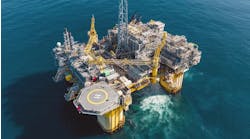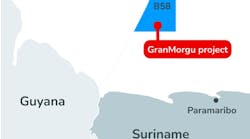René de Koeijer, Olaf Willemse, Ewout Voors - Heerema Marine Contractors
Shell’s Perdido development is a record-setting venture. The list of world firsts includes the deepest ever installation of a spar, 2,384 m (7,820 ft) of water depth; the deepest installation of permanent suction piles, 2,630 m (8,630 ft) of water; the deepest ever flowlines and pipeline end structure, 2,984 m (9,790 ft) of water; and an integrated topsides installation that set a new record for lift weight in the Gulf of Mexico (GoM) at 8,866 metric tons (9,773 tons). Heerema Marine Contractors (HMC) met the challenges of this technically difficult, ultra deepwater installation in a remote location with the threat of hurricanes ever present.
Heerema Marine Contractors main office is located in Leiden, the Netherlands, with engineering offices in Houston, and Bangalore, India. The engineering for the subsea installation contract was performed in HMC’s Houston office with support from both Leiden and Bangalore, while the spar installation was engineered in Leiden, also with support from Bangalore. Formal and informal communication networks were very close knit which resulted in further optimization of installation aids. Especially the SCR installation required a number of installation aids which were similar or identical to the installation aids required by the spar. A good example of this synergy is the installation of a single linear winch and central sheave on the spar top deck, used to pull-in both the nine mooring lines as well as the three SCRs.
Installation highlights
The entireBalder campaign for 2008 was split into four main phases:
- 1. Mooring pile installation
- 2. Flowline installation
- 3. Spar mooring hook-up
- 4. SCR installation.
It was clear from the start that the arrival of the spar hull in the field would take precedence over installation of certain flowlines or any other activity, because installation was scheduled during hurricane season. In event of a storm, flowline installation would have to be interrupted to hook-up to moorings to mitigate exposure of the uninstalled spar hull. On the other hand, if the flowline scope was completed prior to arrival of the spar hull theBalder would have to continue with the pre-lay of the SCRs. Procedures and mitigating measures were developed to suit arrival of the spar hull in the field. Also logistics onboard the Balder were set-up to accommodate maximum flexibility for both pipelay work and more traditional deepwater construction work, and changing from one type of work to the other with minimum interruption.
Suction piles
The Perdido suction piles, the deepest permanent suction piles in the world, were installed in water depths of up to 2,620 m (8,630 ft) and weighed up to 226 metric tons (250 tons).
PLETs
Among the engineering challenges for Perdido was installation of the pipeline end terminations (PLETs). Shell designed each PLET to meet the operational requirements at each specific location, consequently almost were different. The smallest PLET comprised of one connection hub, yet the largest PLET was equipped with four hubs, weighing over 75 metric tons (82.7 tons) and measuring 34 x 20 x 17 ft (10.3 x 6.2 x 5.1 m).
Given the size, shape and weight, the challenge was to develop a procedure to install the PLETs on the seabed without overstressing the adjacent pipe sections. High bending moments were anticipated which, without additional measures, could have caused the flowline to buckle. This was mitigated by including a pipe-in-pipe section adjacent to the PLET to allow for bending moments up to three times higher than the single-wall pipe section. Secondly, a large horizontal force, which required more than 50 metric tons (55 tons) of vessel thrust, was put on the flowline system during the set down of the PLET on the seabed. These two combined to provide enough redundancy for a safe installation of PLETs and flowlines.
Flowlines
Two of the flowlines had a length shorter than the water depth. This provided two challenges.
Since the J-lay tower typically is laid out for second-end PLET installation with a pipelay catenary, without catenary, the second-end PLET line up in the firing line can only be achieved by rotating the J-Lay tower a few degrees off vertical. Consequently, the pipe is exposed to bending slightly over the stinger. The resolution is found by adjusting the stinger roller box settings.
A second installation risk was the possibility of PLET rotation along the pipeline axis during lowering. With the flowline (including two structures) hanging from a single wire, there is no mechanism to prevent spinning. To mitigate this, an “anti-twist” system was developed comprising several taglines on the PLET corners. Two ROVs monitored the PLET constantly during the lowering operation. If needed, they held on to the taglines and pulled the PLET back in position.
Minor subsea items
Delay in the arrival of the spar hull moved forward some of the flowline SCR and minor subsea item scope that originally was to be performed after the hull installation. Minor subsea items such as manifold piles, manifolds, ESP caissons, and ESP inlet assemblies were to be installed in various stages of the entire program. All these items were located at the so called DVA location, i.e. on the sea bottom directly underneath the spar. To allow for schedule flexibility, procedures were developed to install all these items either prior to arrival of the spar or after hooking the spar to its moorings. To allow for installation of these subsea items, the spar was given a dedicated temporary offset to the southeast to allow direct vertical access with theBalder cranes to the installation position and to avoid contact with the mooring lines.
Hull wet tow and upending
Upending the spar from its horizontal tow position to its vertical operational position consists of two phases: soft tank flooding and hard tank ballasting. Soft tank flooding at Perdido was designed to induce a roll of the spar in a predetermined direction. A designed roll ensures that pre-installed components, such as the motor control center and hydraulic power units do not submerge.
The second phase, hard tank ballasting, was optimized to be performed as quickly as possible, without losing track of the stability requirements of the spar.DCV Balder can provide water flow rates of 1,500 m3/hr (6,650 gal/min). Roughly 20,000 m3/ 5.3 MMgal ballast water were required to upend the spar.
Tanks high in the hard tank were used for wet tow stability plus heel and trim requirements. A draining system drained water from these high tanks to the lower tanks in the hard tank to save time and improve stability during upending.
Polyester mooring lines
DCV Balder has the largest mooring deployment winch in the world, with a drum diameter of 10.5 m (34.5 ft) and a width of 14.2 m (46.5 ft). It has a proven track record of over a 100 km of spiral strand and polyester mooring line installed successfully.
Some of the main advantages of this large winch are:
- The 14.2 m width allows for large segments to be spooled single layer to reduce the risk of sheath damage by a top layer cutting into the lower layers on a drum
- Maximum lowering speed of 40 m/min (131 ft/min)
- Protruding outboard to allow obstacle free handling of the polyester rope.
Use of the MLD winch allowed spooling of 9.69-in. diameter polyester rope segments with a length of 1,725 m (5,660 ft), allowing the designer to reduce the number of segments for significant savings on the required connection links.
The sequence in which the mooring lines are installed can be optimized pending the environmental conditions and is determined offshore. Not only does theDCV Balder have good workability features, the large deck space allows storage of multiple mooring lines. These features allow late decision for the mooring line installation sequence along with the actual weather condition and ensures optimal project overall workability and schedule flexibility.
Polyester mooring line installation needs some additional consideration due to unknown stiffness and length properties of the line and stricter installation criteria compared to spiral-strand wire. Currently the MMS requires that polyester mooring lines do not touch the seabed at any time during or after installation. However, both the length and stiffness of the polyester is known only within a certain fabrication tolerance, usually +/- 0.5% of the length. For ultra deepwater this can amount to a length deviation of 100 ft (30.5 m), which is roughly 1% of the water depth. Polyester clearances during installation, however, usually are in the order of magnitude of 10 m (32.8 ft).
These length and stiffness variations can mean a difference of 22% of the inline tensions, which may lead to some components being loaded beyond allowable safe working loads.
It also must be taken into account that due to the low stiffness of the polyester mooring line during installation and a possible spar offset caused, for example, by the loop current, the risk that mooring lines will touch the seabed increases significantly. HMC’s procedures and software are designed to account for these scenarios.
An additional feature on theDCV Balder is its unique equalizer system. During the installation of a spar mooring line, this system allows the vessel to transfer the horizontal component of the pulling force of the mooring line directly to the spar. This allows for greater workability because there is no need to use dynamic positioning to pull the mooring line to the spar. All available thrust can be used for station keeping.
Fixed ballast
One of the last steps of spar installation is the installation of fixed ballast in the soft tank. Fixed ballast usually consists of an inert metal (magnetite). This material was pumped as a slurry from a hopper barge over theBalder’s deck to the top of the spar in. The piping is routed over a fixed ballast boom supported by an installation vessel crane. From the top of the spar, separate piping was routed to each soft tank compartment. The piping was routed over the deck of the installation vessel to reduce the motion sensitivity of the procedure. SSCVs are known for excellent motion characteristics. Routing the piping over a fixed ballast boom allows for a higher access point to the spar, making weather vaning easier for the installation vessel. The motions of both the barge and the SSCV can be reduced by choosing the optimal environmental heading.
SCRs
After the operation mode change, which took effectively one day, theBalder continued with the flowline and SCR installation. The SCRs were installed using the second-end. The prelaid sections of the SCR s were picked up and the pipeline was constructed and completed with a flex joint assembly onboard the Balder.
Thereafter, the SCR pull-in lines, pre-installed on the spar prior to sail-away from Finland, were transferred to theBalder and connected to the FJ assembly. Finally, the entire SCR was lifted outside the J-lay tower and swung towards the spar. With a combination of Balder’s crane and the pull-in equipment on the spar the SCRs flex joint was landed in its porch on the bottom of the spar.
Topsides
In early 2009 HMC installed the integrated topsides of the Perdido Host. With a 9,773 ton lift, a record for the US part of the Gulf of Mexico, theHLV Thialf completed most of the work within two weeks. With 700 berths on the Thialf, a large hook-up crew was able to work towards quarters habitable (when the crew is allowed by the US coast guard to live in the platform living quarters) in a relatively short time. Due to its schedule the Thialf abandoned the hook-up support before completion. Luckily, Balder was available to provide a work platform.
Conclusions
The Perdido Regional Development proved to be a challenging installation project from many angles. The installation in hurricane season and in ultra deepwater posed some obvious challenges. The remote location of Perdido in the Gulf of Mexico (170 mi [274 km] from the nearest shore and 80 mi [129 km] from the closest platform) added to the unique difficulty of the project. With two years of preparation under two separate contracts, HMC’s tasks of engineering, scheduling, and logistics for installation in the flowlines, SCRs, subsea structures, and spar platform were completed successfully in a single continuous campaign in the summer of 2008 by theDCV Balder. HMC’s heavy lift vessel Thialf installed the topsides in spring 2009, with the Balder finishing HMC’s scope for the Perdido development with an integrated installation and hook-up support period.
Editor’s note: This paper is an updated version of a presentation made during the Deep Offshore Technology Conference (DOT) in Monaco, in November 2009.
Hurricane management in a remote section of the GoM
Two major hurricanes and two tropical storms hit the Gulf of Mexico in 2008, and brought additional challenges to the Perdido project. These challenges ranged from a flooded supply base, a flooded heliport, and a damaged engineering office to “simply” evacuating the installation site with theDCV Balder.
Significant effort went into hurricane preparedness and response during the engineering and planning phase of the project, resulting in operational flexibility and a reduction in the amount of downtime caused by these storms.
In the western part of the US Gulf, eight miles from the border with Mexico, the Perdido site is remote by all definitions. The closest platform (Hoover) is more than 80 mi away. It takes a supplier 24 to 48 hours to sail from Galveston or Fourchon to the site. A helicopter ride from Galveston takes almost two hours, and that with a restricted payload. Consequently, it was identified that well-organized logistics would be important for successful project execution, and a number of measures were taken.
In addition to standard procedures for the Gulf of Mexico, specific hurricane response procedures were developed for this locale. The westerly location of the field reduced the possible evacuation routes for theDCV Balder. Detailed planning mapped critical activities, which could lead to longer evacuation times. All in all, a significant amount of effort was put into hurricane preparedness to ensure the safety of the vessels and crews.
The largest critical window was formed by the installation of the spar hull to storm-safe conditions. The spar was considered storm safe with three mooring lines attached. It was decided to pre-install these anchor lines to reduce the time required to connect them to the spar. However, since the polyester anchor lines could not be allowed to touch the seabed, pre-installation meant suspending them from buoys able to withstand hurricane force waves and currents.
Designated helicopters and crews were available round the clock for the duration of the project to accommodate both normal crew changes and medical evacuations. This deviated from the normal practice in more “populated” areas where helicopters are widely available on the spot and flight times are much shorter. In addition,HLV Thialf and DCV Balder each was equipped with a helicopter refueling system. A large effort was made to identify all required equipment and installation aids, as it would take at least two days to get anything from onshore to site. As such, any “missing” items could become very costly by potentially incurring DCV Balder delays.
As a consequence of Hurricane Ike, Galveston was abandoned as the main helicopter base of operations in favor of Corpus Christi, Texas. Galveston also was scheduled as the first response for any medical evacuation of the installation vessels, but due to flooding caused by Ike, this also was shifted to Corpus Christi.
Reflecting on the project, it can be said that the logistical preparations worked well with no major delays. All equipment, components, and resources were delivered on time. The largest logistical issue encountered seemed to occur when theBalder ran out of ketchup during the topsides campaign.




